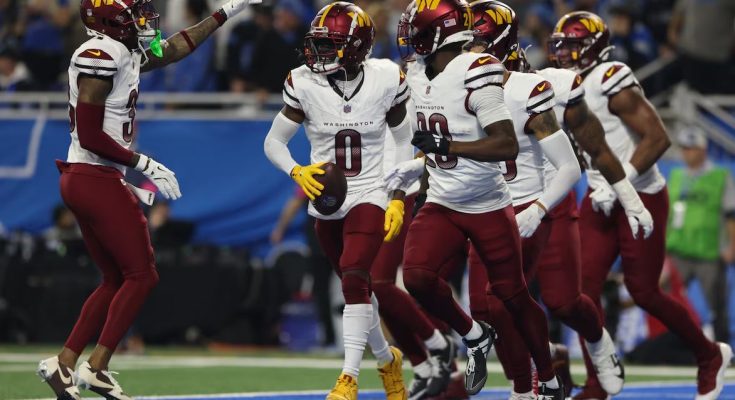The Washington Commanders’ goal this offseason is to build on the momentum from their best campaign in three decades while overcoming the challenge a wise man once described this way: “Remember: Anybody can get it. The hard part is keeping it.”
Here’s what to know about the Commanders’ situation entering free agency, and about the players and positions they seem likely to target.
How much salary cap space do the Commanders have?
Washington has $79.7 million in salary cap space, the third most in the NFL as of Saturday afternoon, according to Over the Cap. But the Commanders, like every team, focus more on the cash budget before working out the cap — and cash is probably a better indicator of how aggressive Peters will be with quarterback Jayden Daniels entering the second year of his rookie contract.
End of carousel
Cash, or a franchise’s dollars spent, is different from the cap, which is an accounting mechanism the league uses to enforce a spending limit. The distinction is important because Peters has two years to spend big on players around Daniels before the quarterback becomes eligible for a new contract in 2027.
The Commanders are committed to spending $164.5 million in cash this season, which ranks 28th in the NFL, according to Over the Cap, though that database has not factored in the team’s most recent deals. Expect the team to spend a lot of cash this offseason, although probably not $100 million because it must maintain reserves for the draft, contract extensions and/or midseason trades. (Teams can use contract tools, such as prorated bonuses, to spend more cash than this year’s $279.2 million cap figure.)
By the end of the offseason, the Commanders’ cash spending will be a decent measure of Peters’s aggressiveness compared with the league’s biggest spenders — which, at least for now, are the Cleveland Browns ($282.1 million) and Philadelphia Eagles ($267.4 million).
Will the Commanders make another splash move?
After trading for Samuel, the Commanders still have the resources to acquire another star player. Whether they actually do so will come down to cost and value.
Maybe they splurge on a bigger-name pass rusher. Maybe they grab another receiver — although, unless they give Samuel a new deal, they would then have three wideouts with significant cap charges this season, a potentially prohibitive move that would run counter to Peters’s general philosophy of building through the draft.
Plus, Peters has said he won’t mortgage the future on any one player unless there is great value in doing so, and he did find plenty of success with lesser-known players across the roster last season. He could again look to the second tier of free agents to find more undervalued talent.
What positions do the Commanders need most?
Among the needs: defensive line help — on the edge and the interior — offensive tackle, wide receiver, cornerback, tight end and safety. Those needs could, of course, change depending on which of Washington’s own free agents return.
So who are the Commanders’ free agents?
There are now 26 total.
On offense: TE Zach Ertz, QB Marcus Mariota, TE John Bates, WR Olamide Zaccheaus, WR Dyami Brown, T Cornelius Lucas, RB Jeremy McNichols, WR K.J. Osborn, LG Michael Deiter, OL Trent Scott, WR Jamison Crowder, WR Noah Brown and QB Jeff Driskel.
On defense: S Jeremy Chinn, DE Dante Fowler Jr., DE Clelin Ferrell, CB Noah Igbinoghene, CB Michael Davis, CB Benjamin St-Juste, DL Sheldon Day, LB Nick Bellore, LB Mykal Walker, DL Jalyn Holmes and S Darrick Forrest.
On special teams: P Tress Way and K Austin Seibert.
Who’s likely to come back from that list?
Ertz and Way are prime candidates to return. They were key contributors on the field and vital voices in last season’s tight locker room. Other starters, such as Chinn, Igbinoghene and Dyami Brown, might have played well enough last season to get sizable deals elsewhere that the Commanders won’t want to match.
Others to watch are Fowler, who led the team with 10.5 sacks but sometimes struggled to set edges against the run, and Bates, who could have a healthy market because of the limited number of blocking tight ends and the value of players who can do that well.
What deals might make sense for Washington?
The price has to make sense in any deal. But in terms of need and talent, acquiring Trey Hendrickson from Cincinnati would give the Commanders the NFL’s reigning sack leader in time to face an onslaught of top quarterbacks next season, including Patrick Mahomes, Jalen Hurts (twice, as usual), Justin Herbert, Jordan Love, Jared Goff, Bo Nix and Tua Tagovailoa. (The Bengals have given Hendrickson permission to seek a trade.)
In free agency, there are a number of appealing pass rushers. Philadelphia’s Josh Sweat, fresh off a Super Bowl victory, is headed for the open market, along with Los Angeles Chargers linebacker Khalil Mack. The Tennessee Titans released outside linebacker Harold Landry III and the Chargers released Joey Bosa, both of whom could sign with a new team now.
It wouldn’t be a surprise if Peters waited until the first few days of free agency passed before cutting a number of deals to nab players in that second tier. Possibilities there might include New York Giants wide receiver Darius Slayton and San Francisco cornerback Charvarius Ward, who signed with the 49ers in 2022, when Peters was their assistant GM.



